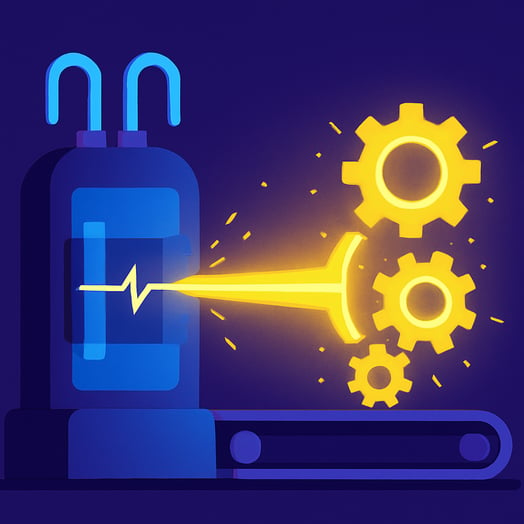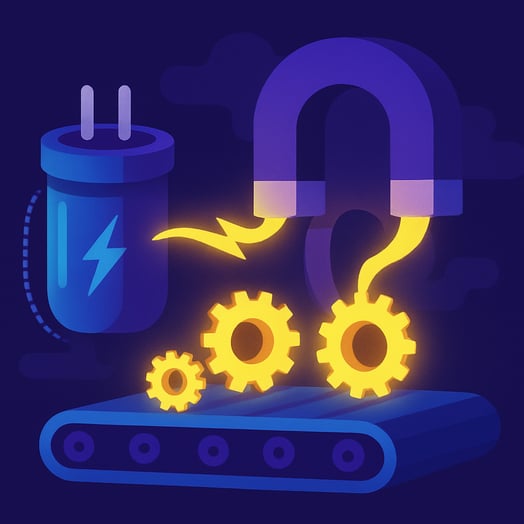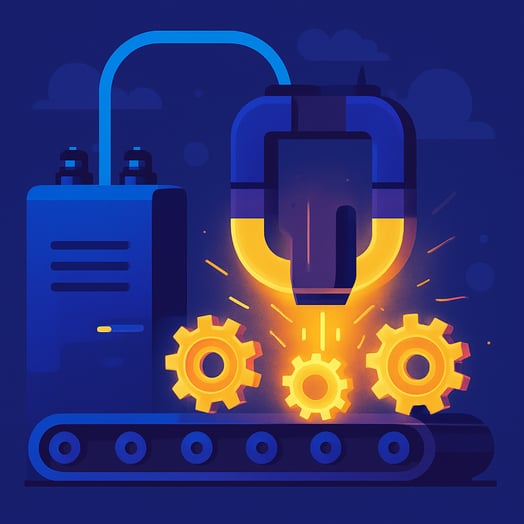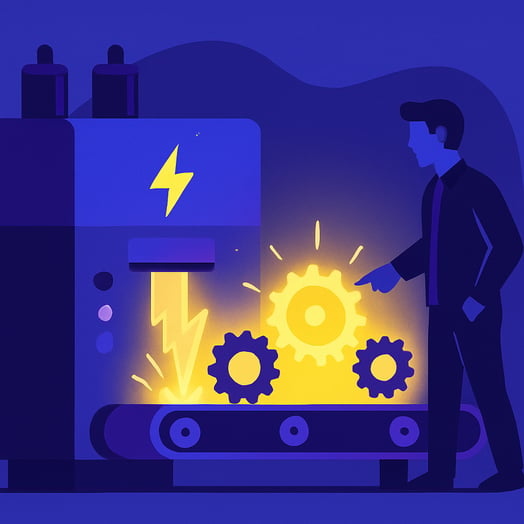Pulse magnetization uses a short, high-current electrical pulse to create an intense magnetic field, fully saturating a magnet in an instant. It is essential in high-volume manufacturing for components like electric motors, automotive sensors, and consumer electronics where speed, power, and precision are critical.
Frequently Asked Questions
What is pulse magnetization?
Pulse magnetization is a process that uses a short, high-current electrical pulse to create an intense magnetic field, which fully saturates and magnetizes a component in a fraction of a second. It is performed by a specialized piece of equipment called a capacitive discharge magnetizer.
Why is pulse magnetization ideal for high-volume manufacturing?
Pulse magnetization is ideal for manufacturing due to its speed, power, and precision. The key advantages include its ability to generate unmatched field strength to saturate high-performance rare earth magnets, its incredible speed for automated production lines, its capability to create complex multi-pole patterns, and its low heat generation, which prevents damage to sensitive parts and allows for continuous operation.
What common products use pulse magnetization?
Pulse magnetization is essential in several key industries. Common applications include creating rotors for electric motors in EVs and robotics, manufacturing automotive components like anti-lock braking system (ABS) sensors, and producing parts for consumer electronics such as the haptic motors in smartphones and the brushless DC motors in washing machines and vacuum cleaners.
How Does Pulse Magnetization Work?

At its core, pulse magnetization is a process of converting stored electrical energy into a powerful magnetic field. This is performed by a specialized piece of equipment called a capacitive discharge magnetizer.
The system works by charging a large bank of capacitors and then discharging that stored energy through a custom-designed coil, known as a magnetizing fixture. This release happens in a fraction of a second, creating a massive current pulse that generates an intense magnetic field—often in the 3 to 5 Tesla range. This brief but powerful pulse is strong enough to fully magnetize even high-coercivity materials like Neodymium (NdFeB) and Samarium Cobalt (SmCo) magnets.
Industrial-grade Magnetizers from specialists like Magnet Applications are engineered to deliver these high-energy pulses with extreme reliability, making them a cornerstone of modern magnet production.
Why Use Pulse Magnetization? The Key Advantages

Pulse magnetization isn't just one way to magnetize a material; for many advanced applications, it's the only way. The process offers several distinct advantages over other methods, like DC electromagnets or permanent magnet magnetizers.
- Unmatched Field Strength: It is the most effective method for generating the intense magnetic fields required to fully saturate high-performance rare earth magnets. Alternative methods simply cannot produce enough power.
- Speed and Efficiency: The entire process takes a fraction of a second, making it ideal for automated, high-volume production lines where thousands of parts must be magnetized per day.
- Complex Magnetization Patterns: Paired with custom fixtures, pulse magnetization can create highly complex multi-pole patterns on a single magnetic component, which is crucial for sophisticated electric motors and sensors.
- Lower Heat Generation: Because the energy pulse is so brief, very little heat is generated in the fixture. This prevents damage to sensitive components and allows for rapid, continuous operation without the need for extensive cooling systems.
Common Applications of Pulse Magnetization in Manufacturing

Pulse magnetization is the unsung hero behind countless modern technologies. Its ability to quickly and precisely magnetize components makes it indispensable in several key industries. For each of these applications, production-ready Magnetizers are essential for achieving consistent quality at scale.
Electric Motors and Actuators
Permanent magnet rotors are the heart of modern brushless DC motors used in everything from electric vehicles (EVs) to industrial robotics. These rotors often require intricate multi-pole magnetic patterns to function efficiently. Pulse magnetization, used with custom-designed fixtures, is the only practical way to impart these complex patterns with perfect accuracy. This is why leading manufacturers rely on fully integrated systems where the Magnetizers and fixtures are designed in-house to match the exact specifications of the motor.
Automotive Sensors and Components
Your car is filled with components that rely on precisely magnetized parts, including anti-lock braking system (ABS) sensors, motor position sensors, and various actuators. This precision is non-negotiable for safety and performance. The speed and reliability of pulse magnetization are perfectly suited for the automotive industry's demanding production environment. PLC-controlled Magnetizers are critical for integrating seamlessly into automated assembly lines, ensuring every sensor is magnetized to the exact same specification.
Consumer Electronics and Home Appliances
From the tiny motors that create haptic feedback in your smartphone to the brushless DC motors in high-efficiency washing machines and vacuum cleaners, pulse magnetization is everywhere. The sheer volume of consumer electronics manufacturing demands a process that is both incredibly fast and energy-efficient. Pulse magnetization delivers on both fronts, enabling the mass production of reliable magnetic components that power our daily lives.
Choosing the Right System for Pulse Magnetization

An effective magnetization strategy isn't just about the machine; it's about the entire system. While DC electromagnets are simpler, they lack the power for rare earth magnets. Permanent magnet magnetizers are not flexible enough for varied industrial needs.
The ideal solution is a capacitive discharge system that is designed in tandem with the magnets and the final product. This holistic approach ensures optimal performance. Key features to look for include:
- In-House Design: A partner who designs and builds both the magnets and the Magnetizers can guarantee perfect synergy between the material and the process.
- Custom Fixtures: The ability to engineer custom magnetizing fixtures is crucial for achieving precise and uniform magnetization, especially for complex geometries like rotors and flywheels.
- Production-Ready Integration: For seamless integration into a manufacturing line, systems must offer PLC-controlled operation, ensuring they can communicate with other automated equipment.
By focusing on an integrated solution, manufacturers can unlock the full potential of their magnetic components, ensuring reliability, performance, and efficiency from the lab to the production floor.


